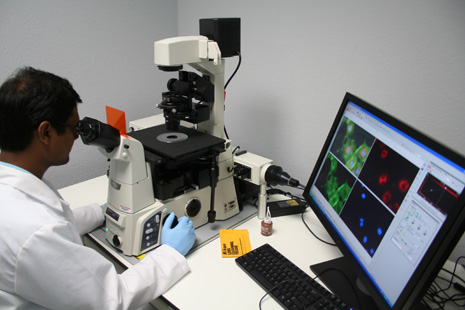
FAYETTEVILLE, Ark. – A new study by a University of Arkansas biomedical engineer and his colleagues at the National Cancer Institute demonstrates further promise for chitosan/interleukin-12 as an effective anti-tumor immunotherapy. The researchers had already demonstrated success with chitosan/IL-12 in the treatment of superficial bladder cancer in mice, for which human clinical trials will likely begin in 2011. But recent findings revealed that injections of chitosan/IL-12 eradicated aggressive colorectal and pancreatic tumors as well.
Experiments also showed that treatment with chitosan/IL-12 inhibited tumor recurrence. The combination of chitosan, a biological adhesive that binds molecules to tissue, and interleukin-12, a drug that stimulates the body’s immune system to attack tumors, increased retention of interleukin-12 in the tumor microenvironment by at least three to four days.
“This is the first study to show enhanced retention of IL-12 in the tumor microenvironment after injecting the drug directly into tumors,” said David Zaharoff, assistant professor of biomedical engineering. “Chitosan increased the retention of IL-12 in the tumor from 1 to 2 days to 5 to 6 days and probably longer. This finding, in addition to results indicating that chitosan/IL-12 immunotherapy seems to protect cured mice from tumor recurrence, is very exciting.”
Zaharoff and his colleagues at the National Cancer Institute, where Zaharoff worked before coming to the University of Arkansas, began the new study after demonstrating in 2009 that chitosan/IL-12 was an effective therapy for superficial bladder cancer. The success of that study hinged on Zaharoff’s idea to combine interleukin-12 and chitosan. Interleukin-12 is a powerful cytokine, a type of protein that allows communication between immune cells.
“We’ve known for more than a decade that IL-12 has the potential to stimulate the body’s immune system to attack a range of cancers,” Zaharoff said. “Unfortunately, IL-12 was found to be extremely toxic and ineffective in early clinical trials when it was administered intravenously. After these trials, interest in IL-12 dropped off tremendously. This wasn’t because IL-12 was a bad drug; we just weren’t delivering it in the right way.”
Zaharoff hypothesized that injecting a tumor with a mixture of interleukin-12 and chitosan, a natural, biodegradable polysaccharide derived from the shells of crustaceans such as shrimp and lobster, would keep interleukin-12 in the tumor and prevent the toxicity associated with interleukin-12 in circulation. His idea worked. Chitosan’s viscosity, which Zaharoff compares to maple syrup, kept interleukin-12 in the tumor microenvironment where it could work for longer periods of time.
Following the initial study, Zaharoff wanted to understand the specific immune responses that caused the tumors to vanish. In the new study, he found that chitosan/IL-12 caused significant expansion of CD8+ T-cells and natural killer cells, two types of powerful immune cells. Depletion of these cells stopped anti-tumor activity. However, depletion of other important immune cells, CD4+ and Gr-1+ cells, had no impact on chitosan/IL-12’s ability to eradicate tumors.
“The CD8 cells and NK cells were revealed as critical immune cell subsets during tumor regression,” Zaharoff said. “This result confirmed other findings on the importance of these particular immune cell subsets in IL-12-based immunotherapies.”
When administered alone, interleukin-12 had only marginal impact. Weekly injections of only interleukin-12 into colorectal and pancreatic tumors in mice eradicated less than 10 percent of established tumors. Complete tumor regression was unique to the chitosan/IL-12 mixture, Zaharoff said. Therapies based on combining chitosan with other cytokines were not successful.
“By no means do we think this therapy is limited to colorectal, bladder and pancreatic cancers,” Zaharoff said. “In fact, we are currently testing chitosan/IL-12 immunotherapy in metastatic breast and prostate tumor models. We feel that this is a broadly applicable immunotherapy that may be used for the treatment of any injectable solid tumor.”
Although researchers measured a significant amount of interleukin-12 in the blood stream after injections into the tumor, toxicities seen in early trials likely would not be duplicated at the suggested schedule of therapy, Zaharoff said. Interleukin-12-related toxicities in humans have been associated with daily administration. People have tolerated weekly or twice-weekly administrations at the maximum-tolerated dose and even higher.
There are other advantages. Chitosan is inexpensive and easily manufactured. Preparation of the chitosan/IL-12 mixture does not require harsh organic solvents. Zaharoff said chitosan and interleukin-12 can be mixed at the patient’s bedside immediately before administration, which eliminates the need for long-term storage.
The researchers’ study was published in the September Journal of Immunotherapy. A copy of the article can be provided upon request or obtained at the journal’s website.
Zaharoff holds the Twenty-First Century Professorship in Biomedical Engineering. In May, he was awarded a Transition Career Development Award by the National Cancer Institute to further his research on Interleukin-12. The award, which totaled $511,368 over three years, is given to fewer than 15 investigators nationwide. The primary objective of the Transition Career Development Award is to help stabilize career tracks of promising investigators while establishing their first independent, cancer-related research programs.
Topics
Contacts
David Zaharoff, assistant professor, biological and agricultural e
College of Engineering
479-575-2005, zaharoff@urark.edu
Matt McGowan, science and research communications officer
University Relations
479-575-4246,
dmcgowa@uark.edu